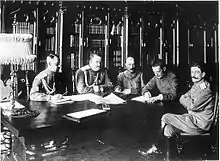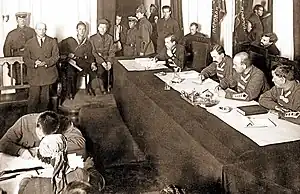Boris Savinkov
Boris Viktorovich Savinkov (Russian: Борис Викторович Савинков; 31 January 1879 – 7 May 1925) was a Russian Empire writer and revolutionary. As one of the leaders of the Fighting Organisation, the paramilitary wing of the Socialist Revolutionary Party, Savinkov was involved in the assassinations of several high-ranking imperial officials in 1904 and 1905.
Boris Savinkov | |
|---|---|
 Savinkov, as Assistant War Minister in 1917 | |
| Born | Boris Viktorovich Savinkov 31 January 1879 |
| Died | 7 May 1925 (aged 46) |
| Cause of death | Defenestration (murder or suicide) |
| Education | St. Petersburg University, Heidelberg University |
| Occupation | Assistant War Minister in Provisional Government |
| Organization(s) | Fighting Organisation 1906–1911 White movement and Union for the Defense of the Motherland and Freedom 1918 |
| Notable work | Memoirs of a Terrorist, The Pale Horse |
| Political party | Socialist Revolutionary Party 1906–1911 |
After the February Revolution of 1917, he became Assistant Minister of War (in office from July to August 1917) in the Provisional Government. After the October Revolution of the same year, he organized armed resistance against the ruling Bolsheviks.
In 1921 he wrote, "The Russian people do not want Lenin, Trotsky and Dzerzhinsky, not merely because the Bolsheviks mobilize them, shoot them, take their grain and are ruining Russia. The Russian people do not want them for the simple reason that .... nobody elected them."[1]
Savinkov emigrated from Soviet Russia in 1920, but in 1924 the OGPU lured him back to the Soviet Union and arrested him. He was either killed in prison or committed suicide.
Young years
Savinkov was born in Kharkov (Kharkiv), the son of a judge in Warsaw. In 1897 he entered the law department of St. Petersburg University but was expelled in 1899 because of participation in students' riots. Later he studied in Berlin and Heidelberg. From 1898 he was a member of various socialist organizations. In 1901 he was arrested and sent to exile to Vologda. He served the exile with some prominent Russian intellectuals including Nikolai Berdyaev and Anatoly Lunacharsky. However, he became disappointed with Marxism and shifted to terrorism. In 1903 Savinkov escaped abroad and joined the Socialist Revolutionary Party, where he soon became Deputy Head of its Combat Organization under Yevno Azef.
Socialist Revolutionary Party
.jpg.webp)
In 1906, he was arrested and sentenced to death for his assassination of Vyacheslav von Plehve, the Russian Minister of Interior, and for participation in the bombing death of Grand Duke Sergei Alexandrovich of Russia. However, he escaped from his prison cell in Odessa - reportedly because a warden agreed to exchange clothes with him, and he walked out, unchallenged, while the warden was arrested and hanged.[2] He left the Russian Empire to avoid recapture. When Azef was exposed as a mole for the Okhrana in 1908, Savinkov was promoted to leader of the SR Fighting Organization, which by now was no longer strong enough to conduct any serious operations. While in France Savinkov volunteered in the French Army during World War I. In April 1917, several months after the February Revolution, he returned to Russia, and in July became Deputy War Minister under Alexander Kerensky. On 30 August, however, he resigned from his post and was expelled from the Socialist Revolutionary Party due to his role in the attempted coup against Prime Minister Kerensky by General Lavr Kornilov.
Civil war

Savinkov remained in Russia after the October revolution and organised a new counter-revolutionary organisation called the Union for the Defense of the Motherland and Freedom, whose headquarters were at 4 Molochny Alley in Moscow, where his deputy Dr. Grigoriev maintained a medical establishment as a façade.
Savinkov, a leader of the Union for the Defense of the Motherland and Freedom, managed the organisation of several armed uprisings against the Bolsheviks, the most notable being in Yaroslavl, Rybinsk, and Murom in July 1918.[3] Savinkov returned to France after these uprisings were crushed by the Red Army. There, he held various posts in the Russian emigre societies and was Admiral Aleksandr Kolchak's primary representative in Paris. During the Polish-Soviet War of 1919–1920, he moved to Poland, where he formed a Russian political organisation responsible for the formation of several infantry divisions and cavalry units out of the former Red Army PoWs. Together with Merezhkovsky, he published in Warsaw a newspaper entitled "For Freedom!" (Russian: «За свободу!», romanized: «Za svobodu!»).
Once the Polish-Soviet War concluded in October 1921, Polish authorities sent Savinkov out of the country in order not to cause further friction with the Soviets.
Trust Operation and death

He was an acquaintance of Sidney Reilly, the legendary renegade British agent, and was involved in a number of counter-revolutionary plots against the Bolsheviks, sometimes collaborating with the British Secret Intelligence Service (SIS). These efforts were effectively undermined by the Trust Operation implemented by the Soviet security agency OGPU. Savinkov was lured into the USSR to meet with false conspirators and was consequently arrested. The USSR Supreme Court sentenced him to death but the Presidium of VTsIK converted the sentence to 10 years imprisonment. During his trial, Savinkov declared that he recognized the Bolsheviks and assumed his defeat. While imprisoned, he wrote satirical stories about white émigrés and was allowed to see them published in Moscow. According to the NKVD, he committed suicide by jumping from a window in the Lubyanka prison, in Moscow. However, according to modern publications by Aleksandr Solzhenitsyn and others, Savinkov was killed in prison by OGPU officers. Semyon Ignatyev wrote at the time of the Doctors' Plot that Stalin complained that the MGB was too humane in its interrogation of prisoners exclaiming, "Do you want to be more humanistic than Lenin, who ordered Dzerzhinsky to throw Savinkov out a window?"[4] (Lenin had been already dead for several months by the time Savinkov returned to Russia.)
Personality
Ilya Ehrenburg, who met Savinkov in Paris in 1916, wrote that: "Never before had I met so incomprehensible and frightening a man. His face was startling because of his Mongolian cheekbones and his eyes, now sad, now extremely cruel; he often closed them, and his lids were heavy... In reality, Savinkov no longer believed in anything. Once he told me that it was the Azef affair that broke him. Up to the very end he had believed the agent provocateur to be a hero... Savinkov turned to writing mediocre novels revealing the inner emptiness of a terrorist who has lost faith in his cause."[2]
Legacy
Boris Savinkov wrote several books. His most famous are two autobiographies: Memoirs of a Terrorist, and the loosely autobiographical novel The Pale Horse. Savinkov's works raised huge controversy among the SRs, with many of them disclaimed as "spoofs" on terrorism.
In Poland, one of the streets in the Praga Północ district was named after Boris Savinkov since 2017, replacing former name referring to the Polish volunteers in the Spanish Civil War (Dąbrowszczacy, named after a communard leader Jarosław Dąbrowski), due to a law forbidding promotion of communism and other totalitarian ideologies.[5] This change was seemed as controversial among some far-left circles, due to Savinkov's ties to White Russia, and the street's name was changed back to Dąbrowszczacy street in 2019.
In popular culture
Films
- Karen Shakhnazarov directed a 2004 film entitled The Rider Named Death based on Savinkov's autobiographical fiction, The Pale Horse.
Television
- Savinkov was played by Clive Merrison in the 1983 BBC miniseries Reilly: Ace of Spies.
Works
- The Pale Horse (novel), 1909 (English edition 1919, online), Russian: Конь бледный (Kon' blednyj) - published under the pseudonym "V. Ropshin"
- What Never Happened: A Novel of The Revolution, 1912 (English edition 1917, online), Russian: То, чего не было (To, chego ne bylo) - published under the pseudonym "V. Ropshin"
- Memoirs of a Terrorist, 1917 (English edition 1931), Russian: Воспоминания террориста (Vospominanija terrorista)
- The Black Horse (novel), 1924 (Russian edition 1923), Russian: Конь вороной (Kon' voronoj)
- In the prison (novel), 1924 (Russian edition 1924), Russian: В тюрьме: Посмертный рассказ (V t'urme: posmernyi rasskaz)
- In France during the war (collection of articles ), 1917 (Russian edition 1917), Russian: Во Франции во время войны (Vo Francii vo vremia voiny) - published under the pseudonym "V. Ropshin"
- Why I Recognized Soviet Power? (collection of articles ), 1924 (Russian edition 1924), Russian: Почему я признал Советскую власть? (Pochemu ja priynal sovetskuju vlast?)
- "Boris Savinkov's Letter to Felix Dzerzhinsky", in The Russian Review, Vol. 29, No. 3 (July 1970), pp. 325–327
Further reading
- Alexandrov, Vladimir. To Break Russia's Chains: Boris Savinkov and His Wars Against the Tsar and the Bolsheviks, Pegasus Books, 2021.
- Spence, Richard B. Boris Savinkov: Renegade on the Left, Columbia University Press, 1991.
- Wędziagolski, Karol. Boris Savinkov: Portrait of a Terrorist, Kingston Press, 1988.
- Carr, Barnes (2020). The Lenin Plot: The Unknown Story of America's War Against Russia. Pegasus Books. ISBN 978-1-64313-317-1.
References
- Volkogonov, Dmitri (1994). Lenin: Life and Legacy. Translated by Shukman, Harold. London: HarperCollins. ISBN 978-0-00-255123-6. Quoted on p.72
- Ehrenburg, Ilya (1961). People and Life, a first volume of autobiography. London: Macgibbon & Kee. pp. 187–88.
- Chamberlin, William (1935). The Russian Revolution, 1917-1921, Volume Two. New York: The Macmillan Company. pp. 57–59.
- To Beria from Ignatiev, 27 March 1953 quoted by Brent, Jonathan, and Naumov, Vladimir P. in Stalin's Last Crime, John Murray (Publishers), London, 2003, p. 218
- "Ulica Sawinkowa - Praga Północ | Warszawa".
External links
- Archive of Boris Viktorovič Savinkov Papers at the International Institute of Social History
- Visions of Terror: Boris Viktorovich Savinkov (1879-1925)
 Media related to Boris Savinkov at Wikimedia Commons
Media related to Boris Savinkov at Wikimedia Commons- Newspaper clippings about Boris Savinkov in the 20th Century Press Archives of the ZBW